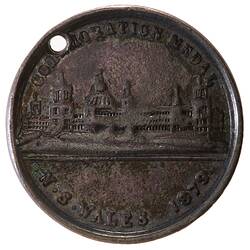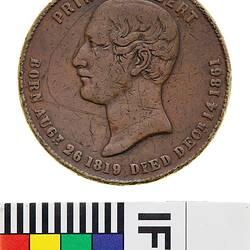Prince Albert, husband of Queen Victoria, was also her cousin. His father, Duke Ernest of Coburg, was a brother of Queen Victoria's mother, the Duchess of Kent. He studied at the University of Bonn and was talented in the arts, and interested in science and technology. Queen Victoria was convinced after some difficulty that she needed a husband, and interviewed a series of European princes. They were all unsatisfactory, except for her handsome German cousin. They were married on February 10, 1840 with Albert in a British field marshal's uniform (Parliament was unhappy with the importation of German royalty).
Albert's role was initially minor, but he balked at being far less than the master in his own house. Within weeks of the marriage, Victoria was pregnant, and Albert increasingly gave Victoria advice and support in the affairs of State. He and Prime Minister Lord Melbourne showed her how to be a ruler in a 'constitutional monarchy' where the monarch had few powers but could exert considerable influence. Albert was a devoted husband and trusted advisor in affairs of state, and became an important aid to Victoria. He also managed her household and took an active interest in the arts, science, trade and industry, and is best remembered for the Great Exhibition of 1851, the profits from which helped establish the South Kensington museums complex. Albert and Victoria's marriage brought nine children between 1840 and 1857, most of whom married into other European royal families: Edward VII (born 1841, married Alexandra, daughter of Christian IX of Denmark); Alfred, Duke of Edinburgh and of Saxe-Coburg and Gotha (born 1844); Arthur, Duke of Connaught (born 1850); Leopold, Duke of Albany (born 1853); Victoria, Princess Royal (born 1840, married Friedrich III, German Emperor and mother to Kaiser Wilhelm II who led Germany into World War I); Alice (born 1843); Helena (born 1846); Louise (born 1848); Beatrice (born 1857). Albert took an active role in their education.
Albert dabbled in almost every aspect of the cultural and intellectual life of his adopted country. He was a serious patron of the arts, a composer and a painter, an architect and an educator. He modernized the obsolete classics-and-theology curriculum with science and technology at Cambridge University. Socially conscious despite his elitism, he arranged for the design and building of experimental houses to better serve working class families. He organized and oversaw the enthralling Great Exhibition of 1851, the first World's Fair and the greatest triumph of his life.
But Albert was not well. By the age of 40 he looked 60. He no longer went shooting and suffered chronic cramps and chills, symptoms of inoperable illness, probably stomach cancer. Late in 1861, he rushed to Cambridge in a chill rain to berate his son Albert about an affair with a prostitute. Returning home, he took to his bed with what was probably pneumonia. His physicians diagnosed typhoid fever, although no other case of the contagious disease had been reported in the area. He was dosed with brandy until he died, at 42, on 14 December 1861.
Victoria was deeply attached to Albert and never recovered from his death. She wore black for the rest of her life. She died 40 years later in 1901, after a reign of almost 64 years. She was buried at Windsor Castle beside Prince Albert.
References:
British Monarchy website http://www.royal.gov.uk
Public Broadcasting Service website http://www.pbs.org/empires/victoria/empire/albert.html
More Information
-
Keywords
-
Localities
-
Authors
-
Article types




